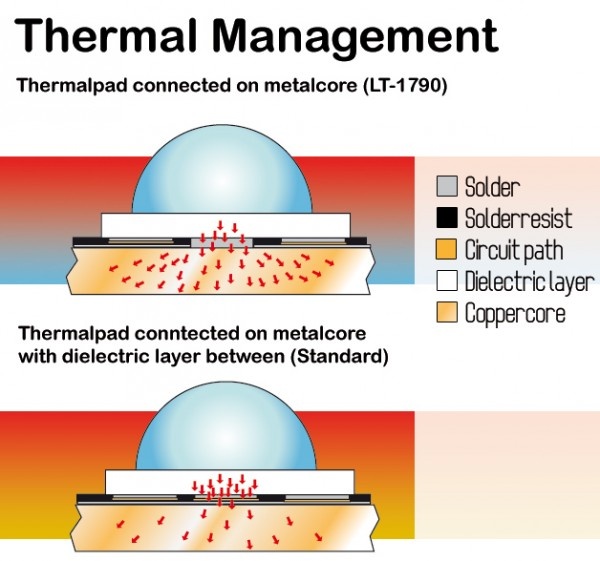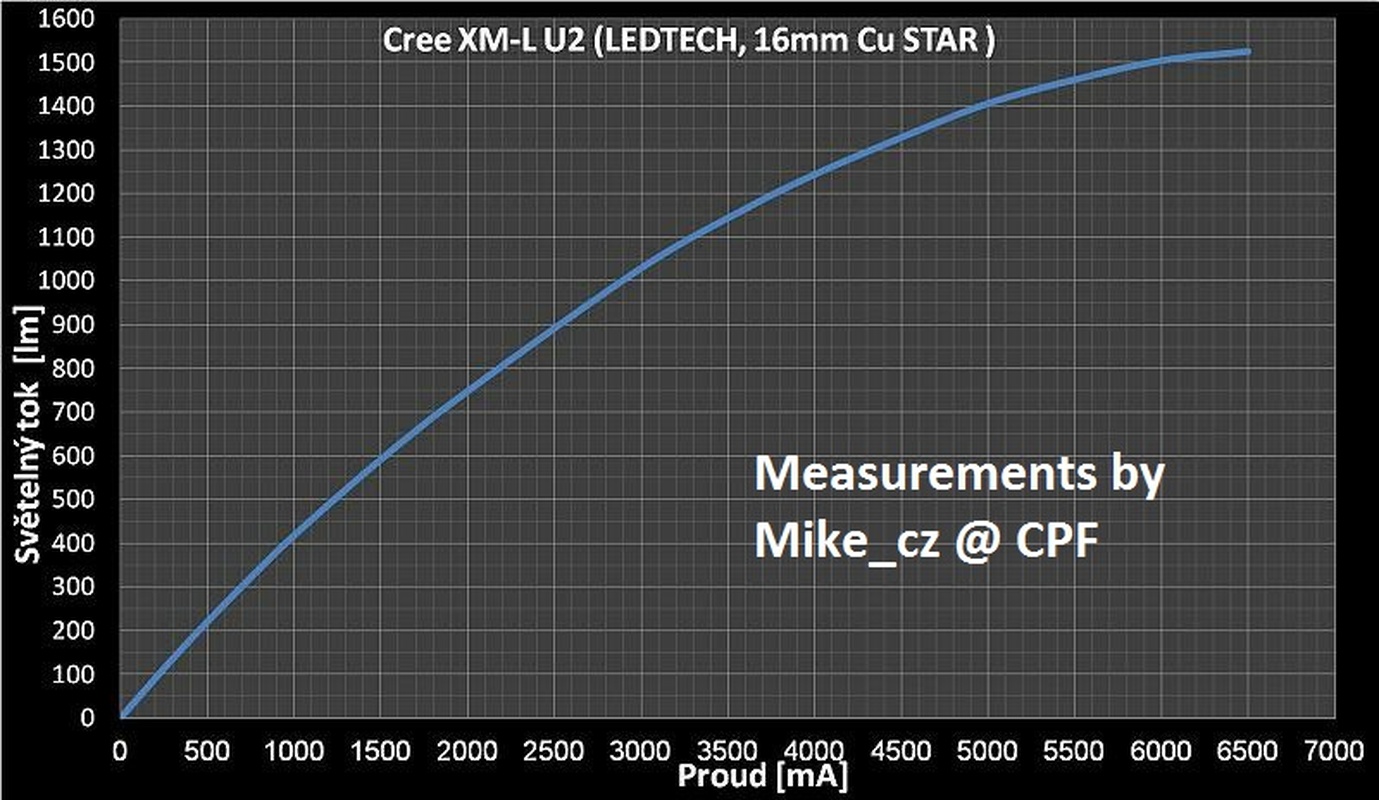You are using an out of date browser. It may not display this or other websites correctly.
You should upgrade or use an alternative browser.
You should upgrade or use an alternative browser.
Difference between MCPCB vs sinkpad
- Thread starter jso902
- Start date
 Help Support Candle Power Flashlight Forum
Help Support Candle Power Flashlight Forum
Epsilon
Enlightened
Difference is that sinkpads (just a type) have the LEDS directly soldered to the star on the center contact. In other stars in general, this just a PCB trace which is insulated from the star by a dielectric layer.
"MCPCB" is just a PCB with metal in it.
This picture will probably clear this:

Picture from www.led-tech.de which sell the XM-L2 LEDS directly to copper soldered.
Graph to show the impact of this:

This graph is from a CPF user (added the credits) very well done . His topic here
"MCPCB" is just a PCB with metal in it.
This picture will probably clear this:

Picture from www.led-tech.de which sell the XM-L2 LEDS directly to copper soldered.
Graph to show the impact of this:

This graph is from a CPF user (added the credits) very well done . His topic here
Last edited:
DIWdiver
Flashlight Enthusiast
To add to what Epsilon said, and because I can barely see it in the pictures even when I know what's there:
An 'ordinary' MCPCB has a very thin fiberglass printed circuit board (PCB) laminated to a metal substrate or core (MC). The center thermal contact of the led would get soldered to a copper pad in the center of the PCB. Then there's a layer of fiberglass board between that and the core. That thin layer has poor thermal conductivity, and almost all the heat has to pass through it. It's very thin though, so in 'normal' applications it's not a problem. These boards are most often done in aluminum because it's cheaper, though copper ones are available (copper has about double the thermal conductivity of aluminum).
An improvement on this is to cut a hole in the fiberglass where the thermal pad is, and fill the hole with solder. Now the LED thermal pad is soldered directly to the core. Solder has a thermal conductivity many times that of fiberglass, so this is a notable improvement.
There's one more improvement that can be made. Copper has thermal conductivity about 8 times better than solder (depending on the alloys). So filling the hole with copper is even better. This is done by deforming the core in a press, so that the core material protrudes into the hole.
Since these improvements are only done for the highest performance levels, AFAIK, they are only done with copper. Also, soldering to aluminum is very difficult, so another reason for only doing it with copper.
All of these are MCPBC's, but with increasing complexity, cost, and performance.
Disagreeing just a bit with Epsilon, 'Sinkpad' is a protected brand name like 'Kleenex', not a generic term like 'facial tissue'.
I'm sure someone will correct me if I'm wrong about this (90 seconds on Google didn't confirm this), but I believe Sinkpads are the once improved technology, where Noctigon makes some parts once improved and some with the doubly improved design. They might even make 'ordinary' copper MCPCB's. Caveat Emptor.
An 'ordinary' MCPCB has a very thin fiberglass printed circuit board (PCB) laminated to a metal substrate or core (MC). The center thermal contact of the led would get soldered to a copper pad in the center of the PCB. Then there's a layer of fiberglass board between that and the core. That thin layer has poor thermal conductivity, and almost all the heat has to pass through it. It's very thin though, so in 'normal' applications it's not a problem. These boards are most often done in aluminum because it's cheaper, though copper ones are available (copper has about double the thermal conductivity of aluminum).
An improvement on this is to cut a hole in the fiberglass where the thermal pad is, and fill the hole with solder. Now the LED thermal pad is soldered directly to the core. Solder has a thermal conductivity many times that of fiberglass, so this is a notable improvement.
There's one more improvement that can be made. Copper has thermal conductivity about 8 times better than solder (depending on the alloys). So filling the hole with copper is even better. This is done by deforming the core in a press, so that the core material protrudes into the hole.
Since these improvements are only done for the highest performance levels, AFAIK, they are only done with copper. Also, soldering to aluminum is very difficult, so another reason for only doing it with copper.
All of these are MCPBC's, but with increasing complexity, cost, and performance.
Disagreeing just a bit with Epsilon, 'Sinkpad' is a protected brand name like 'Kleenex', not a generic term like 'facial tissue'.
I'm sure someone will correct me if I'm wrong about this (90 seconds on Google didn't confirm this), but I believe Sinkpads are the once improved technology, where Noctigon makes some parts once improved and some with the doubly improved design. They might even make 'ordinary' copper MCPCB's. Caveat Emptor.
m4a1usr
Enlightened
The new Cree copper MCPCB available from FT have no substrate in the center solder conduction pad. What you get is a direct electrical and thermal path from the LED to the MCPCB. I know as I tore one apart which sold me on them. Copper 16mm XML Sinkpads on the other hand have a knotched center section that in pressed in to accomplish the same task. I haven't tried a 20mm yet but the 10mm does have a direct path as the Cree. I personally don't think the pressed in piece on the 16mm Sinkpads is an issue although it might raise concerns to those pushing 6 amps or more. I am perfectly happy with the quality of both the 16mm Cree and 16mm Sinkpad versions and plan on continuing to use them in my future builds.
RoGuE_StreaK
Enlightened
I've received samples from Sinkpad that were aluminium versions of the pressed raised contact, which I thought kinda defeated the purpose a bit.Since these improvements are only done for the highest performance levels, AFAIK, they are only done with copper.
I believe (from promo materials) the newer Sinkpads are using a different method, without the indent on the back side; I couldn't tell from the promo materials whether the thermal pad was still raised or whether it was filled with solder; if the latter, to me that's a step backwards.
I think Noctigon uses a raised centre without a pressed indent in the back?
m4a1usr
Enlightened
Thank you for all the info.
Is there an mcpcb pad or sink pad that you would recommend for a tower led? Most are 16-20mm. Or do I need to just cut them ? If I cut one, does that increase the risk of shorting out the led.
Are you building a tower style drop in? The smallest MCPCB I know of is 8mm in diameter. With my KT4 tower builds I don't use an MCPCB. I bond the emitter directly to the brass body. I turn down the very end section to .210 and than file 2 flats for the wires to connect to. You cant get better heat conduction if directly soldering to the pill.
DIWdiver
Flashlight Enthusiast
FYI, the thermal conductivity of brass is around half that of aluminum. Might be better to have it on an aluminum star and bond it to a larger brass base. That might depend on how good the star is.
m4a1usr
Enlightened
FYI, the thermal conductivity of brass is around half that of aluminum. Might be better to have it on an aluminum star and bond it to a larger brass base. That might depend on how good the star is.
That is true. I had contemplated alum towers like LF makes and now Tana is going to be offering his own versions. It does bear some rethinking if I could get past the driver attachment issue. I see Tana has a brass ring pressed in for soldering the driver. I would have to do something similar.
Similar threads
- Replies
- 1
- Views
- 2K
- Replies
- 6
- Views
- 5K
